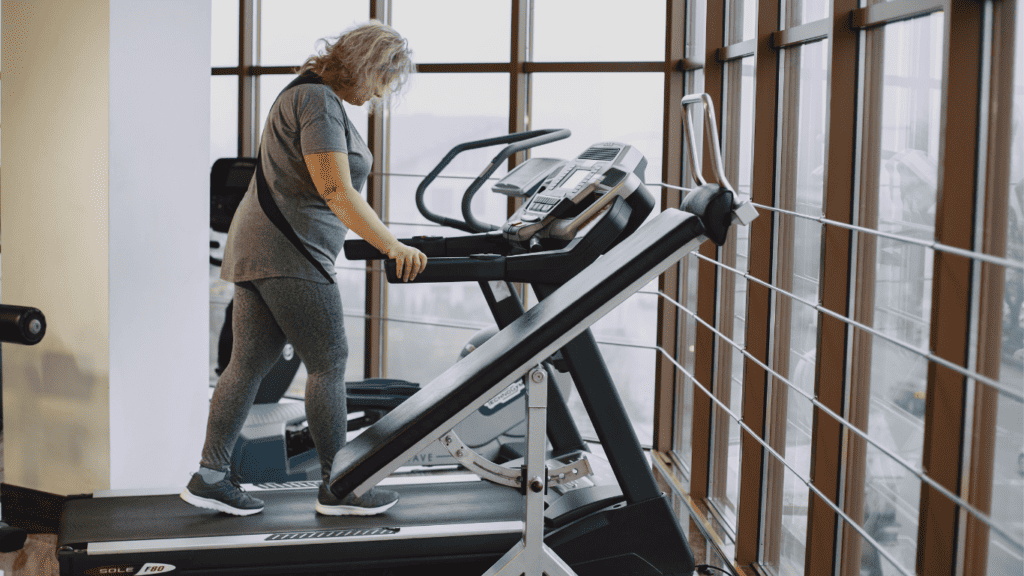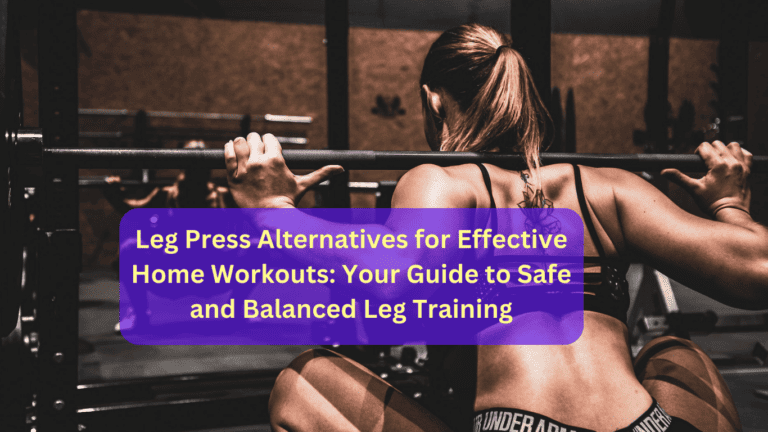11 Tips for How to Run Properly on Treadmill

Running on a treadmill can be an excellent way to stay fit and healthy, but without proper technique, it can also be tough on your body.
With these 13 tips on how to run properly on treadmill, you’ll be able to maximize the benefits of this excellent workout while minimizing the risk of injury.
Our thorough guide will walk you through every step of the process, from setting up the treadmill to adjusting your form and pace.
By the time you’re finished reading, you’ll feel confident and empowered to tackle any treadmill running routine. So don your sneakers, lace up, and let’s get started!
How to Run Properly on Treadmill?
According to ACSM’s Health & Fitness Journal “Safety Lessons Learned from the Jimenez Treadmill Case”, treadmills cause the most injuries of all home exercise equipment.
“This study found that 34% of women and 31% of men who visited the ER for a workout-related injury used a treadmill.”
This is why it’s important to know how to operate and run on a treadmill properly. Follow these treadmill running tips to reduce your risk of injury and get the most out of every workout.
11 Tips for How to Run Properly On a Treadmill?
Tips #1: Warm Up
Warm-up is an essential part of any workout routine, especially for runners who want to reduce the risk of injury and improve performance.
Before you hit the treadmill, it’s crucial to prepare your body for the upcoming workout and gradually increase your speed.
Start a light jog or walk for about 5-10 minutes to get your muscles warmed up and your heart rate up.
Additionally, be sure to perform dynamic stretch out any tight areas that might be prone to injury. By taking the time to warm up before you hit the treadmill, you’ll help your body reach its optimal state of readiness, allowing for a more efficient and safe exercise session.
Tips #2: Understand Your Treadmill
Using a treadmill safely and effectively is an important part of any fitness routine.
Most treadmills you encounter at the gym or in your home come equipped with features to help you achieve your fitness goals, but understanding the treadmill console is key to making the most of these features.
Knowing how to adjust speed and incline, as well as how to read and interpret the various displays, can help you achieve a more effective workout while also avoiding injury.
Taking the time to learn how to safely operate your treadmill is an investment in your health and wellness.
Tips #3: Start Slow

When it comes to incorporating treadmill workouts into your fitness routine, it’s important to remember the old saying: “Slow and steady wins the race.”
Starting with a slow pace and gradually increasing your treadmill speed not only helps prevent injury, but also ensures that you’re safely improving your cardiovascular fitness.
Neglecting safety issues and jumping right into high-intensity treadmill workouts can do more harm than good, leaving you nursing an injury instead of hitting your fitness goals. So take it slow and steady, and watch as the results start to show.
Related Post: 11 Best Incline Treadmill in 2023
Tips #4: Toe Pointing Straight
Ensuring proper running form is essential for any runner looking to improve and avoid injuries. One element that may often be overlooked is toe-pointing.
Keeping your toes pointing straight ahead, rather than outwards or inwards, can positively impact your efficiency and injury prevention.
Maintaining proper toe alignment while running can also help you maintain proper lean forward and avoid relying too heavily on your legs instead of engaging your core and glutes.
So next time you hit the treadmill, take a moment to assess and adjust your toe pointing straight ahead to optimize your running form.
Tips #5: Set the Incline

When it comes to an incline treadmill workout, setting the incline can make all the difference. Whether you’re looking to challenge yourself with a steep incline or add some variety to your routine with a slight incline, adjusting the incline can help you get the most out of your treadmill runs.
Not only does changing the incline engage different muscles in your legs and lower body, but it also helps to prevent boredom and monotony in your workout.
So next time you hit the treadmill, consider playing around with the incline settings to enhance your workout and continue making progress towards your fitness goals.
Tips #6: Choose The Right Speed
Choosing the right speed on a treadmill is crucial to developing an efficient treadmill running technique and achieving the desired fitness level.
As a beginner, it is common to be excited and eager to start running and to hit a fast pace immediately. However, starting with a slower pace can prevent injuries and help build endurance.
It is important to listen to your body, adjust your pace, and gradually increase your speed over time.
A personalized approach to your treadmill workout can ensure that you are optimizing your fitness gains and minimizing the risk of injury.
So start running at the right pace and gradually build up your speed to reach new heights in your fitness journey.
Tips #7: Arm Swing

Arm swing is a crucial aspect of running that often goes unnoticed. A good arm swing can propel you forward and improve your overall running form.
Experienced runners know the importance of keeping their arms relaxed and not crossing them over their bodies.
A natural arm swing that complements your stride can help you run more efficiently and prevent injury. Even when running on a treadmill, maintaining good form and using your arms to enhance your workout can make a significant difference in your overall performance.
So, next time you hit the pavement or the treadmill, pay attention to your arm swing and see the positive impact it can have on your run.
Tips #8: Stay Upright
Maintaining body posture while running doesn’t just look professional, it can actually make you a faster runner.
When you focus on running tall and keeping your body’s center aligned, it allows for more efficient breathing and stride length.
As you keep your head up and shoulders relaxed, your muscles are better engaged, leading to improved performance and less risk of injury.
So, the next time you hit the pavement, focus on staying upright and see how it can transform your running experience.
Tips #9: Pay Attention To Your Stride
For beginner runners, paying attention to your stride can make a huge difference in the quality and effectiveness of your runs.
One aspect of your stride to focus on is your stride count or the number of steps you take per minute. The ideal stride count varies for each individual, but increasing your stride count can lead to less impact on your joints and a more efficient running style.
It’s also important to examine your stride throughout your entire run, not just the beginning or end. Try to maintain a consistent stride and avoid leaning forward too much, which can put unnecessary pressure on your legs and feet.
By practicing and understanding the importance of your stride, you can improve your running technique and maximize your workouts.
Tips #10: Look Straight Ahead
When it comes to running on a treadmill, many people tend to glance down at the dashboard or watch their feet hit the ground.
However, maintaining correct form is key to preventing injury and maximizing your workout.
One important tip is to keep your upper body upright and look straight ahead. This not only engages your core and utilizes proper arm swing, but it also prevents neck strain.
By focusing on keeping your head up and your gaze forward, you’ll be able to maintain better balance and make the most of your treadmill run. Remember, correct form leads to better results.
Tips #11: Proper Footwear
As a runner, investing in proper treadmill running shoes can make all the difference. Not only can it lead to quicker strides, but it can also prevent injuries and promote proper form. For new runners, it can be tempting to just throw on any old pair of sneakers and hit the road.
However, this can lead to inefficient running form and potentially harmful effects on the lower body. Knowing what type of shoe is best for your gait and foot structure can improve running performance and avoid discomfort.
So next time you hit the pavement, take a little extra time to make sure you have the proper footwear for optimal results.
Tips #12: Cool Down & Stretch

Cooling down your body after a vigorous workout is just as important as the workout itself.
While treadmill running is a great exercise to get into shape, it’s critical to stretch before and after your workout to avoid injury and improve flexibility.
In fact, stretching reduces the risk of muscle soreness and promotes blood flow to your muscles.
Make sure to incorporate stretching into your treadmill workout routine by doing dynamic stretches, such as leg swings and arm circles, before running and static stretches, such as lunges and calf stretches, after running.
Safely run on the treadmill and get the best treadmill workout possible by properly cooling down and stretching.
Tips #13: Getting On/Off Properly
Proper form and technique are crucial when getting on and off a fast-moving treadmill.
To ensure safety, step onto the non-moving sections of the treadmill before hitting the start button, and take a few moments to familiarize yourself with the controls.
When it’s time to step off, make sure the treadmill belt has stopped completely before stepping onto the ground.
Remember to keep your eyes forward and avoid looking down at the moving belt, as this can throw off your balance.
By practicing safe and proper techniques for getting on and off a treadmill, you can maximize your treadmill running experience and avoid any potential accidents.
Key Considerations For Successfully Run on a Treadmill
Running on a treadmill is easy, but it’s important to take some key considerations into account to ensure maximum results and safety.
Start by setting realistic goals, and focus on your technique and posture while running.
It’s also best to mix up your treadmill workouts by varying the speed, incline, and distance.
Don’t forget to cool down and stretch so you can reap the full benefits of your treadmill workout.
Make sure you hydrate throughout your workout and practice proper form when getting on and off the treadmill.
Avoid loose clothing on the treadmill, and use the safety key for extra protection.
By following these guidelines, you can safely run on a treadmill to achieve better physical fitness.
Alternative to Treadmill Running
Running on a treadmill can be boring to some individuals, so it’s important to have alternative forms of cardio exercise.
Swimming, cycling, and Elliptical training are great alternatives that will help you reach your health and fitness goals.
You can try out other treadmill workouts such as HIIT treadmill workout, running on the treadmill barefoot, treadmill sprint workout, or hill workout on a treadmill.
Conclusion
When it comes to exercising, safety should always be your priority. Running on a treadmill is an effective and accessible way of burning calories, building muscle, and improving cardiovascular health.
With proper form, technique, and safety measures in place, you can maximize your treadmill running experience. Additionally, there are plenty of alternative options to running on a treadmill if you’re looking for something more exciting.
With the right combination of exercise, nutrition, and rest, you can safely take steps toward a healthier lifestyle.
Disclaimer: The information provided in this blog post is for educational and informational purposes only and should not be construed as medical advice or a substitute for professional medical guidance, diagnosis, or treatment. Always consult with a qualified healthcare professional before starting any exercise program or making changes to your current routine. The author and publisher of this blog post are not responsible for any adverse effects, injuries, or consequences resulting from the use or misuse of the information provided. The reader assumes full responsibility for any actions taken based on the information presented in this blog post.
FAQ
What is the 12-3-30 Rule on the treadmill?
The “12-3-20” workout is a treadmill workout that became popular on YouTube in 2019. It involves doing cardio on the treadmill at an incline of 12, a speed of 3 mph, and intervals of walking pace for 30 minutes.
If you do not have any existing medical conditions that may prevent you from exercising on the treadmill, you can try the 12-3-30 workout.
However, make sure to consult with your doctor before attempting this exercise.
How Do I Run Consistently on a Treadmill?
Running consistently on a treadmill can be a challenging feat to conquer, but with proper training and techniques, it is achievable.
One critical element to keep in mind when running on a treadmill is monitoring your foot strikes. Consistently landing on the ball of your foot will help reduce the impact on your joints and prevent injuries.
Another essential technique is creating a workout plan that gradually builds up your endurance and speed over time. Consider breaking up your training session into intervals of running and walking to avoid burnout.
With a solid plan and consistent effort, running on a treadmill can be a rewarding and effective way to improve your fitness routine.
How Do I Train Myself to Run on a Treadmill?
If you’re looking to add some variety to your workouts or train for a race regardless of what the weather is like outside, treadmill workouts can be a great option.
But how can you train yourself to run effectively on a treadmill?
One key factor is focusing on proper running form, even if it feels unnatural at first – for example, leaning slightly forward to compensate for the lack of resistance from the wind.
Additionally, take the time to gradually increase speed and incline rather than pushing yourself too hard too quickly. With practice and patience, running on a treadmill can become a comfortable and effective part of your exercise routine.
How Should a Beginner Run on a Treadmill?
For beginner runners, running on a treadmill can feel like an easy and efficient way to get started on their fitness journey.
However, it’s important to approach this activity with proper technique and form to avoid injury and maximize results.
One key aspect is to focus on maintaining a natural running form, similar to what you would do if running outdoors.
This means keeping your back straight, engaging your core muscles, and landing on the midfoot rather than the heel.
Additionally, it’s important to gradually increase your speed and incline, rather than jumping into a challenging workout right away. With these tips in mind, beginner runners can safely and effectively utilize a treadmill to improve their fitness levels.





